|
In the justifiable championing of Hammer as the face of British and even international horror cinema from the late 50s through to the early 70s, the good people at Amicus too often get sidelined or even forgotten. When they do get a mention, it's almost always for their treasured run of portmanteau horror features that began in 1965 with Dr. Terror's House of Horrors and included personal favourites Tales From the Crypt (1972) and Vault of Horror (1973). Yet Amicus also produced a sprinkling of non-anthology genre works, films which are still sometimes mistakenly credited to Hammer, hardly surprising given that they often employed the same actors and filmmakers and tended to echo elements of that studio's distinctive house style. The first of these was The Skull, a seductively executed mystery-thriller with a supernatural twist, written by producer and Amicus co-founder Milton Subotsky and directed by Hammer stalwart Freddie Francis.
Following a 15th century prologue that we come back to later, the film opens on an auction whose bidders include the upbeat Christopher Maitland, played by Peter Cushing, and the wealthy but haunted Sir Matthew Phillips, played by none other than Christopher Lee. Are you sure this isn't a Hammer film? The two men are long-standing acquaintances but soon find themselves in a bidding war for the possession of four stone sculpted representations of the hierarchies of Hell. Sir Matthew wins the day, largely because he appears to be in a trance and keeps upping his bid until he's offering far more than the figures are worth. When Maitland asks his friend why he paid so much for them, he is unable to provide an answer because he's not sure himself.
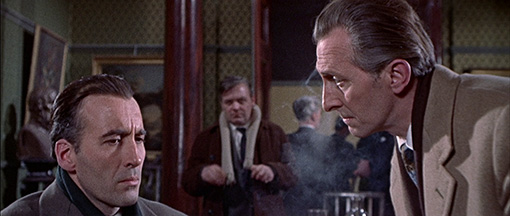
Pestering the tolerant Maitland like an eager purveyor of backstreet pornography is dealer Marco (Patrick Wymark), a shifty dealer in unusual and interesting antiquities. Maitland is a collector who is writing a study of mankind's long-standing fear of what he regards as the forces of superstition, and Marco is the sort of chap who can lay his hands on objects that will aid his research, at least for the right price. Maitland's wife Jane detests the man, but both her husband and Sir Matthew regularly make use of his shady talents. Tonight he shows up at Maitland's door bearing a book that chronicles the life of the Marquis De Sade. He's asking more than Maitland is willing to pay, at least until he reveals that it's bound with human skin.
Marco promises to return the following evening with an even more interesting object, one that will cost Maitland a pretty penny to own. He returns with what he claims is the skull of the Marquis De Sade. Maitland is understandably sceptical, particularly when Marco starts dropping his original asking price of a thousand pounds. To pique Maitland's interest, Marco tells him of the phrenologist who first took the skull from its grave, a man whose story we only caught half of in the prologue. As Marco's tale unfolds in flashback, we discover that the phrenologist came to a sticky end after stripping the head of its remaining flesh. It didn't end there. When the phrenologist's lover returned to the apartment to collect her belongings after his death, she was inexplicably murdered by the kindly old executor of the dead man's estate.
Maitland is left to ponder on the deal and in the course of doing so consults Sir Matthew, who calmly assures him that the skull is genuine. He knows this because it was stolen from him and he's glad to be rid of it, as it's his contention that the Marquis was not mad but possessed by an evil spirit, one that remained trapped in his skull even after his death. His advice to Maitland is to leave well alone, particularly during the nights of the new moon, which frankly is like telling a horror fan that they should steer clear of a movie because it's too scary. Maitland thus sets his sights on obtaining the skull, but even before he has it in his possession it begins to impact on his life and give him cause to start questioning his sanity.
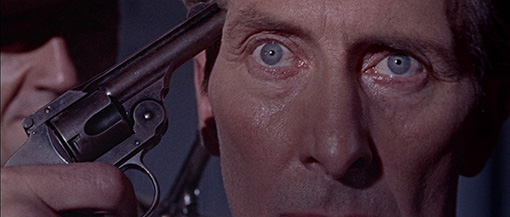
It's a setup with all the elements of a work from Hammer's heyday. The pre-title prologue even plays a little like a tribute to the studio's house style, with its graveyard opening, period costumes, whiff of sexual adventure (full marks to the feline-eyed April Olrich here) and unseen but scream-inducing moment of horror. But in spite of the presence of Hammer's two most marketable stars, there's something just slightly off-kilter about the suggestive framing in that post-title auction scene that sets it apart – at one point the camera circles around the troubled Sir Matthew to frame him against his more positive colleague like a lost-in-thought Ivan the Terrible contemplating his fate. But it's when the film slides invisibly into a surrealistic and inescapably Kafkaesque waking nightmare that the film really shakes off its Hammer influence, a visually striking and genuinely unnerving sequence that would not look out of place in one of the darker toned episodes of The Prisoner two years later.
Adapted from the story The Skull of the Marquis De Sade by Psycho author Robert Bloch, The Skull is light on plot but never feels even remotely anaemic. It's been noted elsewhere that director Francis was forced to improvise around these narrative shortcomings (the script was written quickly and was not feature length) by creatively extending scenes – including what may be horror cinema's longest book reading sequence – in a manner that helps build a discomforting sense of escalating unease. Aiding him in his quest is John Wilcox's prowling camera, a strong music score by Elisabeth Lutyens that intermittently has a ring of Hammer regular James Bernard about it, and a top-notch cast on very fine form. Cushing in particular is excellent as Maitland, appropriately scholarly and sceptical in the early stages and capturing the character's crumbling sanity and drift to the dark side with convincing aplomb. Lee is uncharacteristically and believably downcast as the tormented Sir Matthew, no mean feat for an actor who is usually confident and commanding by default, and Patrick Wymark walks a nice line as the disreputable Marco, revelling in the character's status as a shifty opportunist but never overplaying his inherent sleaziness, despite being given opportunities aplenty to do so.
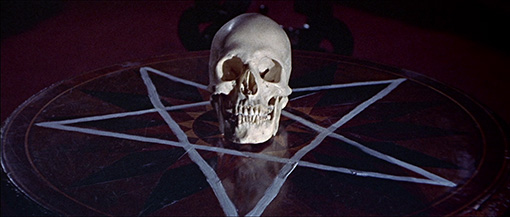
Perhaps the biggest surprise is just how spookily effective the film's key special effect remains and how well it stands up all these years later. The decision to have the skull float through the air under its own steam was a risky one, as it could and by all rights should have looked a little silly. Yes, the strings holding it up are just occasionally visible (thanks a lot, HD), but the manner in which it is filmed and the smoothness of its movement sells the whole thing as uncannily real. There are also a number of inventive and even forward-looking touches in Francis's direction, from the POV shots in which the action is viewed through the skull's eye sockets to the spectacular stunt whose crucial moment is immediately repeated from a different angle, later to become something of an action movie favourite. There's even a shot from Maitland's viewpoint as he walks through his house with a knife held before him that prefigures a key image from the opening sequence of John Carptenter's Halloween – the knife even goes slightly out of focus when it's first picked up, just as it does in Carpenter's film.
In spite of its lightweight plotting, The Skull is a strangely effective and creepily unsettling work from the golden age of British cinematic horror and one the best of Amicus's non-compendium genere works. And while no-one is going to claim that this is based on a true story, it is worth noting that a while after his death, De Sade's skull was indeed removed from his grave for phrenological study. The rest, we can assume, is mere speculation.
Having first encountered them either on shoddy pan-and-scan prints on TV or at late night cinema screenings, where the prints always seemed to be missing frames and plastered with scratches, I always get a thrill when I see a British horror film from the 1960s brought as splendidly back to life as The Skull has been for the Blu-ray in this new Eureka dual format release. Framed in its original ratio of 2.35:1 (and this is one film that really suffered when cropped for 4:3 TV), the image is in excellent shape, boasting an attractive contrast range, a strong level of picture detail and a solid colour palette (the stained glass window in Marco's building looks particularly nice), something that really comes to life in the nightmare sequence, which is visually something of a showcase for the film and this transfer. There's hardly a dust spot to be seen and the image sits solidly in frame throughout. A fine layer of film grain is visible and does not appear to have been subject to enhancement.
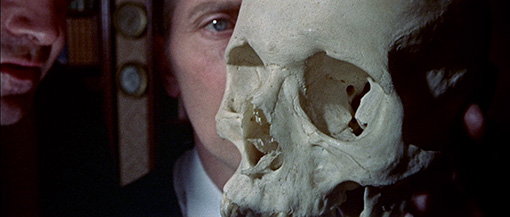
The Linear PCM mono 2.0 soundtrack is also in good shape, with very clear reproduction of dialogue and sound effects, more bass to the music score than you'd expect from a film of this vintage and no distracting background hiss during the quieter scenes. About 20 minutes in, as Marco is presenting the skull to Maitland, the sound level seems to drop slightly, but this doesn't last long.
Optional SDH subtitles are available.
Jonathan Rigby Interview (24:14)
English Gothic: A Century of Horror Cinema and Studies in Terror: Landmarks of Horror Cinema author Jonathan Rigby delivers a enthrallingly detailed examination of the film and its merits. The original story and the changes made for the film version are explored, as are the numerous appearances of the name Maitland in the Amicus filmography and the steps taken by Freddie to visually enhance Subotsky's under-length script. Rigby salutes the casting, the performances, Bill Constable's set design and Elisabeth Lutyens' score, and convincingly suggests a Harold Pinter influence on the nightmare sequence. There's plenty more here, all of it well worth hearing. Great stuff.
Kim Newman Interview (27:18)
The always enjoyable Mr. Newman offers his own appreciation of the film and provides a useful overview of how Amicus Films came to be and how their output differed from Hammer's. He expands on the influences on the nightmare sequence by offering up Hitchcock's Spellbound and Orson Welles' film of Kafka's The Trial (both make persuasive sense), has a welcome dig at the still sniffy attitude of the mainstream press to horror cinema, and suggests that seen late at night, The Skull is a film where the dread creeps up on you (nice). There's plenty more of real interest here. The perfect companion to Rigby's contribution and with surprisingly little crossover between the two.
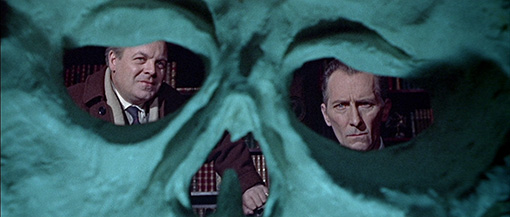
Booklet
The centrepiece of this typically fine booklet is an excellent new essay on the film by Vic Pratt, who steals my thunder a bit by also noting that the nightmare sequence visually foreshadows The Prisoner. At the back there are reproductions of some of the choice press material from the film's release, including some splendid suggestions for its promotion, my favourite being a 'Skull-Shocktail Party'. Consider yourself invited.
A minor gem from Hammer's too-often overlooked pricipal competitor, a smartly directed and very nicely performed chiller that works wonders with its underdeveloped plot and builds on the intrigue of its early scenes to increasingly unsettling effect. It looks terrific on Eureka's Blu-ray, and the extra features really compliment the film. Warmly recommended.
|